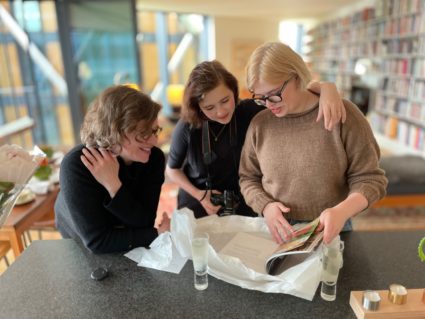the ultimate French food

When I was 16, I spent a summer in France. I know, it sounds like the beginning words to a very cheesy, or tragic, novel. No, it was simply the beginning of the rest of my life. I discovered perfume, pain au chocolat, advanced French grammar, the joys of a Deux Chevaux, and love. What more could anyone want from life?
And strangely, all these things have figured strongly in my adult life, albeit in different forms and at different times. The perfume I loved went defunct, but I found a new one (still French). Pain au chocolat is still my daughter’s favorite breakfast treat. Lovely friends in London years ago drove a Citroen, and love? I will never forget that particular Frenchman, but my lovely husband now listens to tales of him and my adventures with a raised eyebrow and total acceptance.
What France did not bring to me, until many years later, was a love of French food. Besides, that is, pain au chocolat, which I consider not so much a food as sanctioned candy, masquerading as breakfast.
No, French food escaped me for years, understandably since I lived in Indiana, Pennsylvania and New Jersey, until I got married and moved to London, now 20 years ago. Then, because I was writing a dissertation on French art, I had to (had to!) spend time in Paris. And there… I found… cassoulet.
Now, make no mistake, I was no foodie. There weren’t foodies, as far as I know, besides Julia and James and Craig. There was just the world, who far from living to eat, ate to live (if they were lucky). But there were also French people, and French people have always understood the overriding importance of food in life, which I now believe in implicitly and explicitly and every other way. Food is life.
I remember very little of my months in Paris, mostly a fog of this or that bibliotheque, an indigestible mass of information about late 19th century French sculpture, and coming home to yet another rent-by-the-week apartment to eat a tin of tunafish, which in France comes flavored with things like tomato sauce, capers and olive oil. I might have had a cracker with this concoction, then fallen straight to sleep.
But when John came to visit me, we ate. Because he was a man, and therefore hungry. I stayed in many skeevy flats, in many horrid neighborhoods, but once I stayed in the guest room of a friend who lived opulently in the Seventh Arrondisement, and there we found Cafe Max. It was always only a simple out of the way French bistro, like hundreds of others in Paris, and even now it has almost no internet presence, no reputation, no visibility. I was treated kindly at Cafe Max because I spoke fluent French, one of my few skills in life. We sat down, out of the rain, I ate my first confit de canard, my first pate, my first EVERYTHING. And John ate his first cassoulet. And we never forgot a single mouthful.
Candles sputtering, everything brought to the table family-style, you simply helped yourself to whatever amount you wanted, and I don’t remember how it was billed. Red wine in non-labelled bottles, tap water in lovely blue-bottomed bottles, rain, always Parisian rain, spattering outside, the foreign French sirens blaring in and out. Mustardy salad, sometimes with soft-boiled egg on top, hard country breads, unsalted and tough outside, but fluffy and soft within, the room got darker and the smoke from everyone’s cigarettes got thicker. I’m no smoker, but I can’t imagine Cafe Max is the same, if the ban has reached that far.
Memories from another life, when I was young enough to find Paris frightening, yet determined to knock on every door to do my research, to meet all the people I needed to meet. And at night, I was alone, alone, alone. In whatever rented apartment I had managed to find for that three-week period of time, longing all the while for John, far away in London. Youthful adventures are wasted on the young! Silly me, not just to dive in and enjoy everything, even the scary solitude.
And yet I did dive in, as best I could. At least I went, and I was there, however frightened on the inside. And while in those days I was an anti-bean lady, I could see and smell the point of John’s cassoulet: predominantly GARLIC, and FAT, and breadcrumbs, crunchy on top.
I have given almost no thought in the intervening years to Paris (except when I went back) or to cassoulet, until John said last week:
“I’ve been wishing for… a casserole, only what on earth do I mean by that?”
“Campbell’s Cream of Mushroom?” I ask, referring to our ENTIRE childhood, which actually can be encapsulated in a can of soup.
‘No, something GOOD… I don’t know what I mean.”
But I did. Something in me returned to France, to my 20-something self, to goose fat and sausage and duck and baguettes and rainy nights. I went off to the grocery store, bought roughly everything in it, rolled up my sleeves, cancelled everything else I had to do for the day, and produced:
Classic Cassoulet
(serves 8)
for the confit:
4 duck legs
coarse sea salt
4 fat garlic cloves, finely chopped
4 bay leaves, broken in half
1 cup white wine
for the cassoulet:
4 Toulouse sausages
350g/12oz belly pork, skinned and diced
350g/12oz lamb neck fillet or rolled breast, diced
1 large onion, chopped roughly
2 large carrots, chopped roughly
2 celery sticks, chopped roughly
400g/14oz can chopped tomatoes
1 tbsp tomato purée
2 heaped tbsp fresh flat leaf parsley, chopped
1 heaped tbsp fresh thyme, chopped
sea salt and pepper
290ml/½ pint dry white wine
2 cans haricot or cannellini beans, drained and rinsed
850ml/1½pt chicken stock
for the topping:
1 large day-old baguette (or 1 cup fresh homemade breadcrumbs)
2 fat garlic cloves, halved
4 tbsp butter
2 heaped tbsp fresh flat leaf parsley, chopped
1 heaped tbsp fresh thyme, chopped
Place the duck legs skin side down in a skillet with a lid, sprinkle with the salt, garlic and bay leaves and pour the white wine around. Place the lid on top and cook at the tiniest simmer possible, for two hours. Of course, for real confit you’d pour the winey fat over the duck and preserve it, but no need for that step here, as you’ll be using the duck straightaway.
Meanwhile, place the sausages in a 220C/425F oven and bake for 20 minutes. Set aside to cool.
In a large stovetop- and ovenproof dish that will hold all the ingredients, place the belly pork and heat gently until fat begins to be released, then raise heat and cook, stirring occasionally, until all the fat has been released and the pork is crisp, but not dry. Lift the pork onto a plate with a slotted spoon, leaving all the fat behind.
Add the lamb to the pork fat and cook until colored on all sides, then lift out with slotted spoon and set aside with the pork.
Add the diced vegetables to the pork fat and cook till soft. Tip the ingredients from the plate back into the dish. Add the tomatoes, tomato purée and herbs, then season with sea salt and pepper to taste.
Add the wine, haricot beans and chicken stock to the dish and bring to the boil. Stir, then lower the heat so the liquid is just simmering. Keep the mixture in the same dish to cook or transfer it to an earthenware dish.
When the duck has cooked for two hours, remove it from the wine and fat and cool to handle. Remove the skin from the duck, then tuck the duck legs into the cassoulet.
Peel off the sausage skins, slice the sausagemeat thickly on the diagonal and add to the dish.
Cover the dish and bake for 1 hour, stirring once. Stir, then cook uncovered for a further 1–1½ hours, stirring halfway, until the meat is really tender and the sauce is thickened. Take the dish out of the oven and remove the duck legs. Strip the meat from the bones (it will fall off easily) and return the meat to the dish. Stir and add a little water, if necessary. Season if necessary, then return to the oven and bake for another 15 minutes until all the meat and beans are very tender.
For the topping, cut the crusts off the baguette, tear the bread into pieces and put in a food processor. Add the garlic and chop into coarse crumbs (you should have about a cup of garlicky bread crumbs).
Heat the butter in a large frying pan until sizzling, then stir fry the breadcrumbs and garlic over a moderate to high heat for 7–8 minutes until crisp and golden. Remove from the heat, toss in the herbs and stir to mix, then season well with salt and pepper.
Ladle the cassoulet in generous servings into warm bowls, sprinkle on a bit of topping, and serve.
******************
Be warned: this is a labor-intensive recipe, with many steps, lots of cooking time and attention. It’s not difficult, because each task is simple in itself. But you must be in the mood to potter about the kitchen for the better part of the day.
Here’s a tip that worked for my family: Avery does not like beans, and so I knew that the entire cassoulet would not be to her liking. So I simply made an extra duck leg confit, and when the others went into the cassoulet, hers waited until just 20 minutes before dinner and then roasted in a hot oven, skin side up. Perfect.
Once the cassoulet is thoroughly cooked, it can sit in the refrigerator for up to a day, wanting only to be reheated at a low temperature before serving, so it’s perfect for those days when you’re out until an hour or so before you want to eat.
Your reward for all that dicing and stirring and simmering will be the richest aroma stealing through your house, your family asking if we can eat early, and all you need besides the cassoulet is a traditional green salad with a very mustardy dressing, and a warm baguette, torn into pieces that fit in the hand.
Pure France, in a soup bowl, topped with buttery, garlicky breadcrumbs. You really can’t ask for more than that on a shivery February evening.

